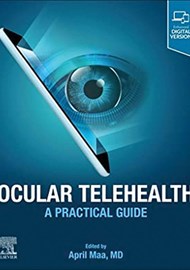Ocular Telehealth: A Practical Guide is in its first edition, which is great considering the recent adjustments to practical medical delivery that the COVID-19 pandemic has mandated. Overall, this book is well written in a structured format defining the uses of ocular telehealth to each subspecialty within ophthalmology. There are also high-quality, relevant images which enable the reader to clearly visualise authors’ key statements.
Recent technological developments have led to the creation and application of multiple modalities and methods that allow medical practitioners in a variety of specialties, including ophthalmology, to remotely diagnose and instigate treatment of a wide range of ocular disorders.
This book has a strong focus on the importance of population health management and how telehealth can play a huge role in ensuring these services can be utilised in remote areas to make ocular healthcare more accessible.
Every chapter also has a section on future directions to demonstrate ongoing research within each subspecialty to aid accurate diagnoses and better management of ocular conditions. I was particularly amazed by the idea of a ‘drive-through IOP check’ for patients during the COVID-19 pandemic to aid glaucoma testing.
Ocular Telehealth also provides the reader with case studies demonstrating possible real-world use of virtual follow-up clinics in suitable patient groups. In this way, the clinician can decide if a subsequent face-to-face appointment is necessary. The authors of the book acknowledge that tele-ophthalmology services are an adjunct to in-person eyecare and not a replacement.
In later chapters, vital information such as the technology considerations for implementing healthcare programs, costs, and barriers to setting up these services is discussed. The authors also talk about the ethical and legal considerations in relation to setting up ocular telehealth systems.
Ocular Telehealth by Maa and colleagues has made it clear that over the past few years, telemedicine has made significant advancements. Patients may benefit from faster identification and early treatment of eye illnesses through telehealth screenings and automated diagnoses thanks to continuous breakthroughs in tele-ophthalmology and artificial intelligence (AI), which will lead to better care and improved visual outcomes for patients. With multiple advancements in ocular telehealth to come, I cannot wait to read a second edition of this book.





